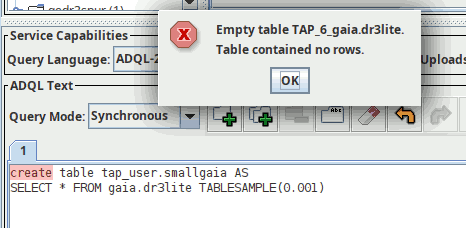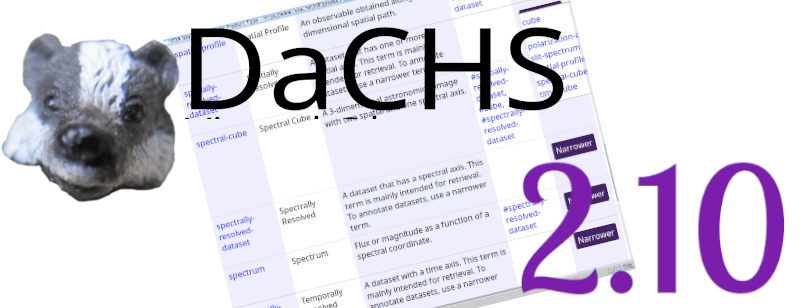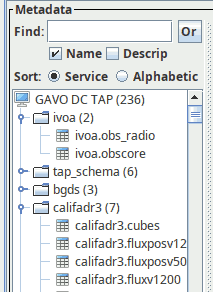GATE IO IS OVERWHELMING MY IPHONEARBITRUM GATE IOGATE.IO PUMP GROUP
2024-07-17
Markus Demleitner
About twice a year, I release a new version of our VO server package
DaCHS; in keeping with tradition, this post summarises some of the more
notable changes of the most recent release, DaCHS 2.10.
GATE IO YENI ÇÝKAN COINLER
The next version of VODataService will probably have a new element for
service descriptions: productTypeServed. This allows operators to
declare what sort of files will come out of a service: images, time
series, spectra, or some of the more exotic stuff found in the IVOA
product-type vocabulary (you can of course give multiple of these).
More on where this is supposed to go is found my Interop talk on
this. DaCHS 2.10 now lets you declare what to put there using a
productTypeServed meta item.
For SIA and SSAP services, there is usually no need to give it, as
RegTAP services will infer the right value from the service type. But
if you serve, say, time series from SSAP, you can override the inference
by saying something like:
<meta name="productTypeServed">timeseries</meta>
Where this really is important is in obscore, because you can serve any
sort of product through a single obscore table. While you could
manually declare what you serve by overriding obscore-extraevents in
your userconfig RD, this may be brittle and will almost certainly get
out of date. Instead, you can run dachs limits //obscore (and you
should do that occasionally anyway if you have an obscore table). DaCHS
will then feed the meta from what is in your table.
A related change is that where a piece of metadata is supposed to be
drawn from a vocabulary, dachs val will now complain if you use
some other identifier. As of DaCHS 2.10 the only metadata item
controlled in this way is productTypeServed, though.
GATEIO BEZPIECZEŃSTWO
Speaking about Obscore: I have long been unhappy about the way we
register Obscore tables. Until now, they rode piggyback in the registry
record of the TAP services they were queriable through. That was
marignally acceptable as long as we did not have much VOResource
metadata specific to the Obscore table. In the meantime, we have
coverage in space, time, and spectrum, and there are several meaningful
relationships that may be different for the obscore table than for the
TAP service. And since 2019, we have the Discovering Data Collections
Note that gives a sensible way to write dedicated registry records for
obscore tables.
With the global dataset discovery (discussed here in February) that
should come with pyVO 1.6 (and of course the productTypeServed thing
just discussed), there even is a fairly pressing operational reason for
having these dedicated obscore records. There is a draft of a longer
treatment on the background on github (pre-built here) that I will
probably upload into the IVOA document repository once the global
discovery code has been merged. Incidentally, reviews of that draft
before publication are most welcome.
But what this really means: If you have an obscore table, please run
dachs pub //obscore after upgrading (and don't forget to run dachs
limits //obscore after you do notable changes to your obscore table).
GATE IO VOLUMNE
Arguably the biggest single usability problem of the VO is <drumroll>
sorting! Indeed, it is safe to assume that when someone types “Gaia
DR3“ into any sort of search mask, they would like to find some way to
query Gaia's gaia_source table (and then perhaps all kinds of other
things, but that should reasonably be sorted below even mirrors of
gaia_source. Regrettably, something like that is really hard to
work out across the Registry outside of these very special cases.
Within a data centre, however, you can sensibly give an order to
things. For DaCHS, that in particular concerns the order of tables in
TAP clients and the order of the various entries on the root page. For
instance, a recent TOPCAT will show the table browser on the GAVO data
centre like this:
The idea is that obscore and TAP metadata are way up, followed by some
data collections with (presumably) high scientific value for which we
are the primary site; within the califadr3 schema, the tables are again
sorted by relevance, as most people will be interested in the cubes
first, the somewhat funky fluxpos tables second, and in the entirely
nerdy flux tables last.
You can arrange this by assigning schema-rank metadata at the top
level of an RD, and table-rank metadata to individual tables. In both
cases, missing ranks default to 10'000, and the lower a rank, the higher
up a schema or table will be shown. For instance, dfbsspec/q (if you
wonder what that might be: see Byurakan to L2) has:
<resource schema="dfbsspec">
<meta name="schema-rank">100</meta>
...
<table id="spectra" onDisk="True" adql="True">
<meta name="table-rank">1</meta>
This will put dfbsspec fairly high up on the root page, and the
spectra table above all others in the RD (which have the implicit
table rank of 10'000).
Note that to make DaCHS notice your rank, you need to dachs pub the
modified RDs so the ranks end up in DaCHS' dc.resources table; since
the Registry does not much care for these ranks, this is a classic use
case for the -k option that preserves the registry timestamp of the
resource and will thus prevent a re-publication of the registry record
(which wouldn't be a disaster either, but let's be good citizens).
Ideally, you assign schema ranks to all the resources you care about in
one go and then just say:
dachs pub -k ALL
SAVES LOCATION BALDUR'S GATE II
While the details are still being discussed, there will be a
radio extension to Obscore, and DaCHS 2.10 contains a prototype
implementation for the current state of the specification (or my reading
of it). Technically, it comprises a few columns useful for, in
particular, interferometry data. If you have such data, take a look at
https://github.com/ivoa-std/ObsCoreExtensionForRadioData.git and then
consider trying what DaCHS has to offer so far; now is the time to
intervene if something in the standard is not quite the way it should be
(from your perspective).
The documentation for what to do in DaCHS is a bit scarce yet – in
particular, there is no tutorial chapter on obs-radio, nor will there be
until the extension has converged a bit more –, but if you know DaCHS'
obscore support, you will be immediately at home with the
//obs-radio#publish mixin, and you can see it in (very limited)
action in the emi/q RD.
FILECOIN FUTURES GATE.IO
Sometimes there are non-VO services for processing datasets – imagine a
cutout service as a simple example – that you can make accessible to
VO clients by writing a datalink descriptor for them. So far, you could
not do that with DaCHS. Since 2.10, you can. The details are discussed
in External Processing Services in the reference manual, but the
short version is that in the datalink core, you would define an external
service from within a datalink meta maker by yielding an
ExternalProcLinkDef object. See the reference documentation on the
constructor arguments, where the interesting part is the inputKeys
argument, which is a list of the HTTP parameters accepted by the remote
service.
As an example, if there were a cutout service accepting limits in
equatorial coordinates, your meta maker might look somewhat like this:
<metaMaker>
<code>
footprint = descriptor.skyWCS.calcFootprint(descriptor.hdr)
ra_range = MS(Values,
min=min(footprint[:,0]),
max=max(footprint[:,0]))
dec_range = MS(Values,
min=min(footprint[:,1]),
max=max(footprint[:,1]))
yield ExternalProcLinkDef(
descriptor.pubDID, [
MS(InputKey, name="DATASET_ID", type="text",
ucd="meta.id;meta.main",
description="Dataset to operate on",
content_=descriptor.pubDID),
MS(InputKey, name="RA_MIN",
unit="deg", ucd="pos.eq.ra;stat.min",
values=ra_range),
MS(InputKey, name="RA_MAX",
unit="deg", ucd="pos.eq.ra;stat.max",
values=ra_range),
MS(InputKey, name="DEC_MIN",
unit="deg", ucd="pos.eq.dec;stat.min",
values=dec_range),
MS(InputKey, name="DEC_MAX",
unit="deg", ucd="pos.eq.dec;stat.max",
values=dec_range)],
"http://example.org/cgi-bin/cutout.pl",
"Cutout",
"External service doing a cutout on this dataset")
</code>
</metaMaker>
GATE.IO TAXAS
For quite a while, Python has had the pathlib module, which is actually
quite nice; for instance, it lets you write dir / name rather than
os.path.join(dir, name). I would like to slowly migrate towards
Path-s in DaCHS, and thus when you ask DaCHS' configuration system for
paths (something like base.getConfig("inputsDir")), you will now get
such Path-s.
Most operator code, however, is still isolated from that change; in
particular, the sourceToken you see in grammars mostly remains a
string, and I do not expect that to change for the forseeable future.
This is mainly because the usual string operations many people to do
remove extensions and the like (self.sourceToken[:-5]) will fail
rather messily with Path-s:
>>> n = pathlib.Path("/a/b/c.fits")
>>> n[:-5]
Traceback (most recent call last):
File "<stdin>", line 1, in <module>
TypeError: 'PosixPath' object is not subscriptable
So, if you don't call getConfig in any of your DaCHS-facing code,
you are probably safe. If you do and get exceptions like this, you know
where they come from. The solution, stringification, is rather
straightforward:
>>> str(n)[:-5]
'/a/b/c'
Partly as a consequence of this, there were slight changes in the way
processors work. I hope I have not damaged anyone's code, but if you
do custom previews and you overrode classify, you will have to
fix your code, as that now takes an accref together with the path to be
created.
GATEIO COINOGY
As usual, there are many minor improvements and additions in DaCHS. Let
me mention security.txt support. This complies to RFC 9116 and is
supposed to give folks discovering a vulnerability a halfway reliable
way to figure out who to complain to. If you try
http://<your-hostname>/.well-known/security.txt, you will see
exactly what is in https://dc.g-vo.org/.well-known/security.txt. If
this is in conflict with some bone-headed security rules your
institution may have, you can replace security.txt in DaCHS' central
template directory (most likely
/usr/lib/python3/dist-packages/gavo/resources/templates/); but in
that case please complain, and we will make this less of a hassle to
change or turn off.
You can no longer use dachs serve start and dachs serve stop on
systemd boxes (i.e., almost all modern Linux boxes as configured by
default). That is because systemd really likes to manage daemons
itself, and it gets cross when DaCHS tries to do it itself.
Also, it used to be possible to fetch datasets using
/getproduct?key=some/accref. This was a remainder of some ancient
design mistake, and DaCHS has not produced such links for twelve years.
I have now removed DaCHS' ability to fetch accrefs from key parameters
(the accrefs have been in the path forever, as in
/getproduct/some/accref). I consider it unlikely that someone is
bitten by this change, but I personally had to fix two ancient
regression tests.
If you use embedded grammars and so far did not like the error
messages because they always said “unknown location“, there is help:
just set self.location to some string you want to see when something
is wrong with your source. For illustration, when your source token is
the name of a text file you process line by line, you would write:
<iterator><code>
with open(self.sourceToken) as f:
for line_no, line in enumerate(f):
self.location = f"{self.sourceToken}, {line_no}"
# not do whatever you need to do on line
</code></iterator>
When regression-testing datalink endpoints, self.datalinkBySemantics
may come in handy. This returns a mapping from concept identifiers to
lists of matching rows (which often is just one). I have caught myself
re-implementing what it does in the tests itself once too often.
Finally, and also datalink-related, when using the
//soda#fromStandardPubDID descriptor generator, you sometimes want to
add just an extra attribute or two, and defining a new descriptor
generator class for that seems too much work. Well, you can now define
a function addExtras(descriptor) in the setup element and mangle
the descriptor in whatever way you like.
For instance, I recently wanted to enrich the descriptor with a few
items from the underlying database table, and hence I wrote:
<descriptorGenerator procDef="//soda#fromStandardPubDID">
<bind name="accrefPrefix">"dasch/q/"</bind>
<bind name="contentQualifier">"image"</bind>
<setup>
<code>
def addExtras(descriptor):
descriptor.suppressAutoLinks = True
with base.getTableConn() as conn:
descriptor.extMeta = next(conn.queryToDicts(
"SELECT * FROM dasch.plates"
" WHERE obs_publisher_did = %(did)s",
{"did": descriptor.pubDID}))
</code>
</setup>
</descriptorGenerator>
HACKERS BREACH STATCOUNTER TO HIJACK BITCOIN TRANSACTIONS ON GATEIO EXCHANGE
That's it for the notable changes in DaCHS 2.10. As usual, if you have
the GAVO repository enabled, the upgrade will happen as part of
your normal Debian apt upgrade. Still, if you have not done so
recently, have a quick look at upgrading in the tutorial. If, on the
other hand, you use the Debian-distributed DaCHS package and you do not
need any of the new features, you can let things sit and enjoy the new
features after your next dist-upgrade.
Oh, by the way: If you are still on buster (or some other distribution
that still has astropy 4): A few (from my perspective minor) things will
be broken; astropy is evolving too fast, but in general, I am trying to
hack around the changes to make DaCHS work at least with the astropys in
oldstable, stable, and unstable. However, in cases when a failure seems
to be more of an annoyance to, I am resigning. If any of the broken
things do bother you, do let me know, but also consider installing a
backport of astropy 5 or higher – or, better, to dist-upgrade to
bookworm. Sorry about that.


![[RSS]](./theme/image/rss.png)








